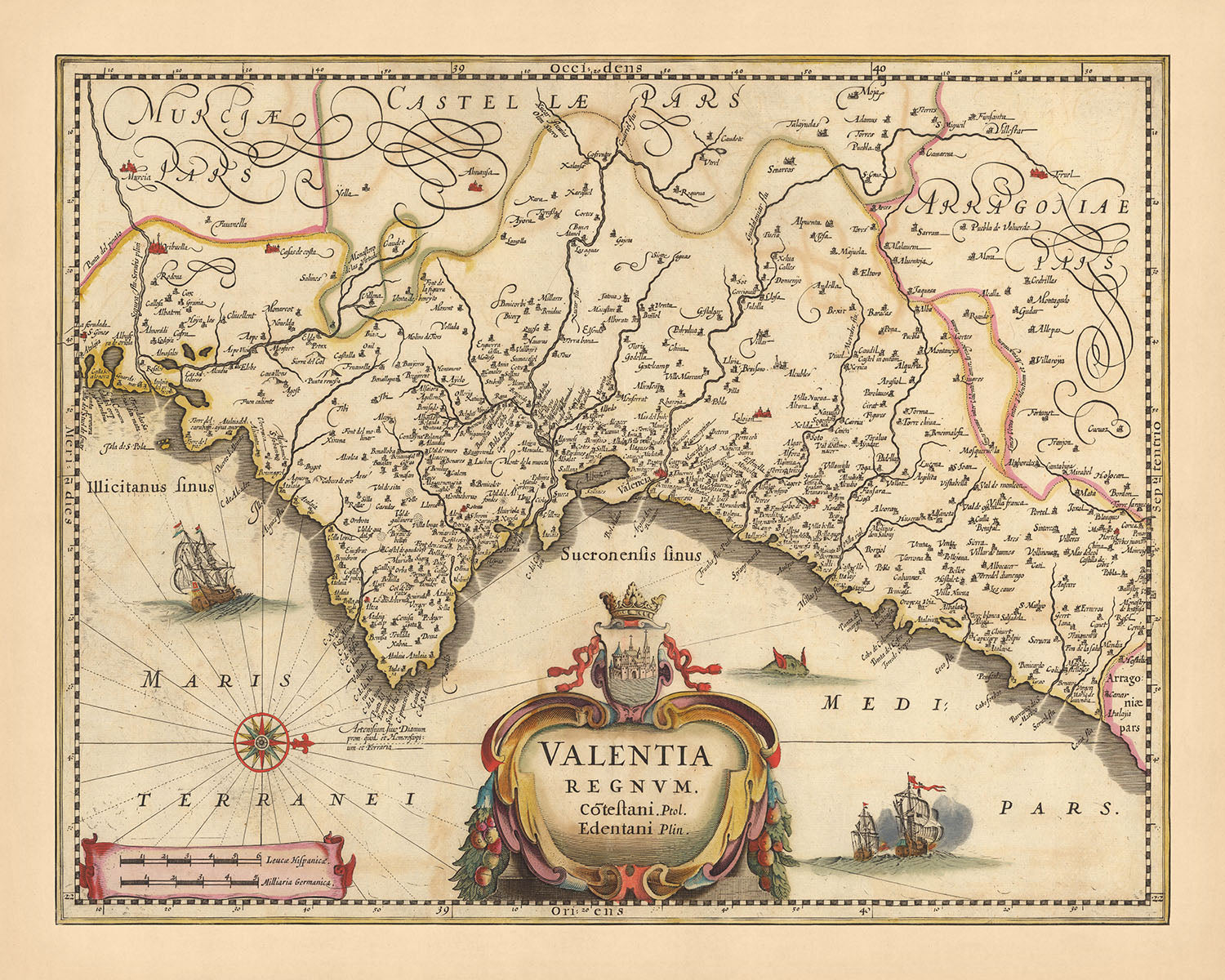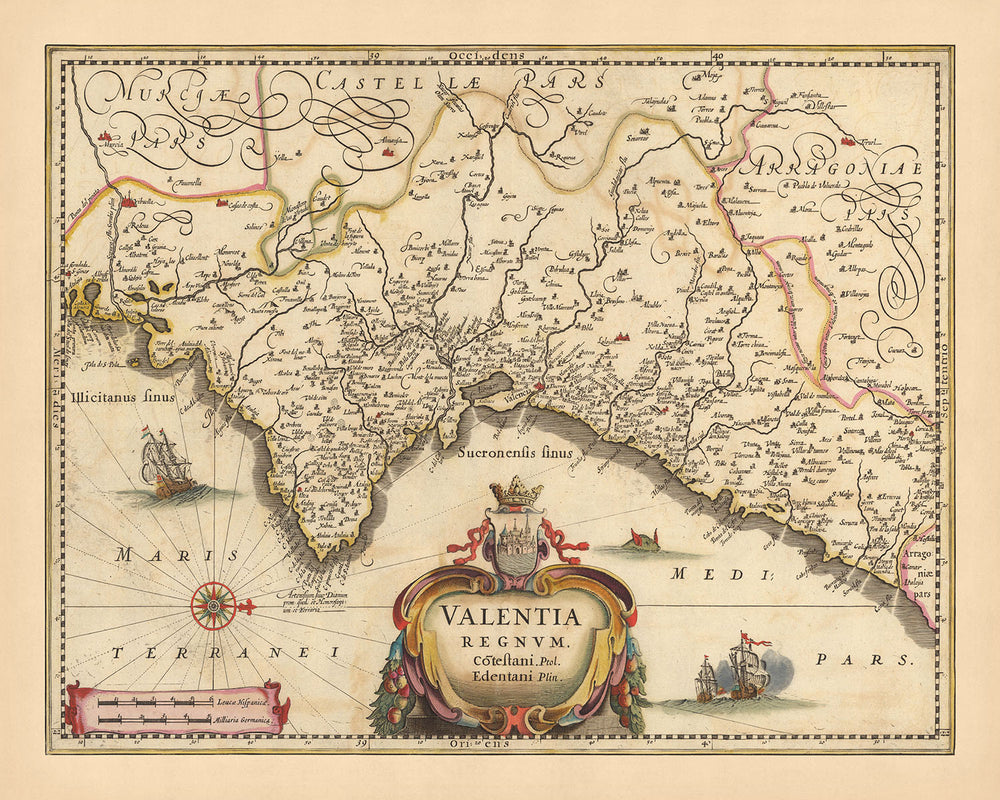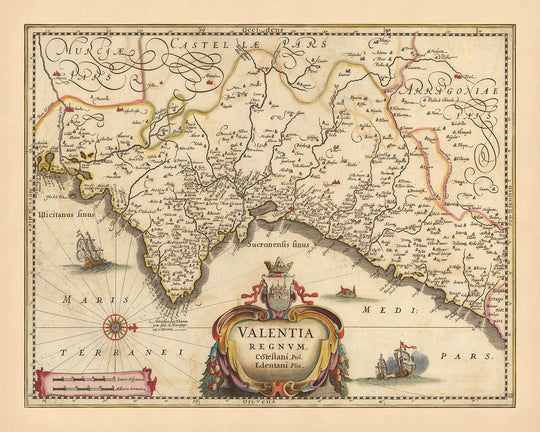- Handmade locally. No import duty or tax
- FREE Delivery by Christmas
- Love it or your money back (90 days)
- Questions? WhatsApp me any time
Own a piece of history
5,000+ 5 star reviews


Immerse yourself in the grandeur of the past with the magnificent 'Valentia Regnum. Contestani. Ptol. Edentani Plin' map, an exquisite piece of cartographic artistry by Nicolaes Visscher II. Crafted in 1690, this map showcases the Kingdom of Valencia, a region that now forms a part of modern-day Spain. The full name of the map translates to 'Kingdom of Valencia. Contestani. Ptolemy. Edetani Pliny', providing a glimpse into the diverse regions and political divisions depicted on this map. Visscher, the grandson of Claes Janszoon Visscher, one of the most respected mapmakers of the Dutch Golden Age, brings the same level of precision and detail to this map, making it a truly luxurious item for any discerning collector.
The map is a treasure trove of historical and geographical information, featuring cities like Murcia, Valencia, Alicante, Dénia, and Castellón de la Plana. These urban centers, each with their unique history and cultural significance, are depicted with meticulous attention to detail. The map's intricate design also reveals a myriad of landmarks, borders, and natural phenomena that are sure to captivate any history or geography enthusiast.
Hand-colored in outline, the map is centered on Valencia, a city known for its rich history and architectural splendor. The map displays administrative boundaries, towns, forests, waterways, canals, mountains, and landmarks, offering a comprehensive view of the region. The decorative cartouches, compass rose, and rhumb lines add to the map's aesthetic appeal, while the relief shown pictorially provides a sense of depth and realism.
This map is not just a historical artifact, but a testament to the artistry and skill of the cartographers of the past. It beautifully combines historical information with artistic design, making it a perfect addition to any collection. Whether you're a map enthusiast, a history buff, or simply someone who appreciates fine art, the 'Valentia Regnum. Contestani. Ptol. Edentani Plin' map is sure to captivate and inspire. Its rich detail and historical significance make it a truly luxurious piece, worthy of any discerning collector.
Some of the significant locations shown on this map:
Kingdom of Valencia
- Valencia: Known as Valentia Edetanorum in Roman times, it's the third-largest city in Spain and a major economic and cultural center.
- Alicante: Known as Lucentum ("Place of Light") by the Romans, it's famous for its historic Mediterranean port.
- Castellón de la Plana: Founded by the Moors in the 13th century, it's known for its rich history and beautiful architecture.
- Elche: Known as Helike by the Greeks and Ilici by the Romans, it's famous for its palm groves, the largest in Europe.
- Gandia: Known for its Borja (Borgia) Palace, it was an important cultural and commercial center during the 15th and 16th centuries.
- Alzira: Founded by the Moors, it was a significant agricultural and commercial center.
- Orihuela: Known as Orcelis under the Romans and Aurariola by the Moors, it's famous for its historic buildings and monuments.
- Xàtiva: Known as Saetabis by the Romans, it's famous for its castle and for being the birthplace of the Borgia Popes.
- Sagunto: Known as Saguntum in Roman times, it's famous for its ancient Roman theater and castle.
- Torrent: An important agricultural center known for its ceramics industry.
- Paterna: Known for its ceramics and pottery industry.
- Manises: Famous for its ceramics, especially tin-glazed pottery.
- Alcoy: Known for its textile industry and the Moros y Cristianos festival.
- Benidorm: Originally a small fishing village, it's now a famous tourist destination.
- Villarreal: Known for its ceramics industry.
- Vila-real: Known for its orange groves and ceramics industry.
- Cullera: Known for its historic castle and beautiful beaches.
- Sueca: An important agricultural center known for its rice production.
- Oliva: Known for its historic Moorish quarter and beautiful beaches.
- Altea: Known for its old town with white houses and cobblestone streets.
Contestani
- Murcia: Founded by the emir of Cordoba, it's known for its historic cathedral and beautiful gardens.
- Cartagena: Known as Carthago Nova during the Roman period, it's famous for its rich archaeological heritage.
- Lorca: Known for its historic castle and beautiful baroque architecture.
- Mazarrón: Known for its beautiful beaches and the mining of lead and silver during the Roman period.
- Aguilas: Known for its beautiful beaches and the castle of San Juan de las Águilas.
- Yecla: Known for its wine production and furniture industry.
- Jumilla: Known for its wine production.
- Cieza: Known for its peach production and the historic Church of La Asunción.
- Totana: Known for its ceramics industry.
Edetani
- Llíria: Known as Edeta in ancient times, it's famous for its Roman archaeological sites.
- Segorbe: Known for its historic cathedral and medieval walls.
Notable Natural Phenomena
- Albufera Natural Park: A lagoon and estuary on the Gulf of Valencia, it's a popular destination for birdwatching.
- Montgó Natural Park: Known for its diverse flora and fauna, it offers beautiful views of the Mediterranean Sea.
- Júcar River: Known for its beautiful canyons and the historic towns along its banks.
- Segura River: Known for its fertile valley, which is a major agricultural area.
- Peñón de Ifach: A massive limestone outcrop, it's a famous landmark on the Costa Blanca.
Notable Historical Events (1600-1690)
- The Expulsion of the Moriscos (1609-1614): This was a decree by King Philip III of Spain ordering the expulsion of the Moriscos (descendants of the Muslim population that had converted to Christianity) from the Kingdom of Valencia.
- The Battle of Almansa (1707): Although it took place slightly after the period specified, this was a significant event in the War of Spanish Succession, which had lasting effects on the region.
- The creation of the Tribunal de las Aguas (Water Court) of Valencia: This ancient institution for resolving irrigation disputes was given formal recognition by King Philip II in 1591.
Please double check the images to make sure that a specific town or place is shown on this map. You can also get in touch and ask us to check the map for you.
This map looks great at all sizes: 12x16in (30.5x41cm), 16x20in (40.5x51cm), 18x24in (45.5x61cm), 24x30in (61x76cm), 32x40in (81.5x102cm), 40x50in (102x127cm), 48x60in (122x153cm) and 56x70in (142x178cm), but it looks even better when printed large.
I can create beautiful, large prints of this map up to 90in (229cm). Please get in touch if you're looking for larger, customised or different framing options.
The model in the listing images is holding the 16x20in (40.5x51cm) version of this map.
The fifth listing image shows an example of my map personalisation service.
If you’re looking for something slightly different, check out my collection of the best old maps of Europe and European cities to see if something else catches your eye.
Please contact me to check if a certain location, landmark or feature is shown on this map.
This would make a wonderful birthday, Christmas, Father's Day, work leaving, anniversary or housewarming gift for someone from the areas covered by this map.
This map is available as a giclée print on acid free archival matte paper, or you can buy it framed. The frame is a nice, simple black frame that suits most aesthetics. Please get in touch if you'd like a different frame colour or material. My frames are glazed with super-clear museum-grade acrylic (perspex/acrylite), which is significantly less reflective than glass, safer, and will always arrive in perfect condition.
This map is also available as a float framed canvas, sometimes known as a shadow gap framed canvas or canvas floater. The map is printed on artist's cotton canvas and then stretched over a handmade box frame. We then "float" the canvas inside a wooden frame, which is available in a range of colours (black, dark brown, oak, antique gold and white). This is a wonderful way to present a map without glazing in front. See some examples of float framed canvas maps and explore the differences between my different finishes.
For something truly unique, this map is also available in "Unique 3D", our trademarked process that dramatically transforms the map so that it has a wonderful sense of depth. We combine the original map with detailed topography and elevation data, so that mountains and the terrain really "pop". For more info and examples of 3D maps, check my Unique 3D page.
For most orders, delivery time is about 3 working days. Personalised and customised products take longer, as I have to do the personalisation and send it to you for approval, which usually takes 1 or 2 days.
Please note that very large framed orders usually take longer to make and deliver.
If you need your order to arrive by a certain date, please contact me before you order so that we can find the best way of making sure you get your order in time.
I print and frame maps and artwork in 23 countries around the world. This means your order will be made locally, which cuts down on delivery time and ensures that it won't be damaged during delivery. You'll never pay customs or import duty, and we'll put less CO2 into the air.
All of my maps and art prints are well packaged and sent in a rugged tube if unframed, or surrounded by foam if framed.
I try to send out all orders within 1 or 2 days of receiving your order, though some products (like face masks, mugs and tote bags) can take longer to make.
If you select Express Delivery at checkout your order we will prioritise your order and send it out by 1-day courier (Fedex, DHL, UPS, Parcelforce).
Next Day delivery is also available in some countries (US, UK, Singapore, UAE) but please try to order early in the day so that we can get it sent out on time.
My standard frame is a gallery style black ash hardwood frame. It is simple and quite modern looking. My standard frame is around 20mm (0.8in) wide.
I use super-clear acrylic (perspex/acrylite) for the frame glass. It's lighter and safer than glass - and it looks better, as the reflectivity is lower.
Six standard frame colours are available for free (black, dark brown, dark grey, oak, white and antique gold). Custom framing and mounting/matting is available if you're looking for something else.
Most maps, art and illustrations are also available as a framed canvas. We use matte (not shiny) cotton canvas, stretch it over a sustainably sourced box wood frame, and then 'float' the piece within a wood frame. The end result is quite beautiful, and there's no glazing to get in the way.
All frames are provided "ready to hang", with either a string or brackets on the back. Very large frames will have heavy duty hanging plates and/or a mounting baton. If you have any questions, please get in touch.
See some examples of my framed maps and framed canvas maps.
Alternatively, I can also supply old maps and artwork on canvas, foam board, cotton rag and other materials.
If you want to frame your map or artwork yourself, please read my size guide first.
My maps are extremely high quality reproductions of original maps.
I source original, rare maps from libraries, auction houses and private collections around the world, restore them at my London workshop, and then use specialist giclée inks and printers to create beautiful maps that look even better than the original.
My maps are printed on acid-free archival matte (not glossy) paper that feels very high quality and almost like card. In technical terms the paper weight/thickness is 10mil/200gsm. It's perfect for framing.
I print with Epson ultrachrome giclée UV fade resistant pigment inks - some of the best inks you can find.
I can also make maps on canvas, cotton rag and other exotic materials.
Learn more about The Unique Maps Co.
Map personalisation
If you're looking for the perfect anniversary or housewarming gift, I can personalise your map to make it truly unique. For example, I can add a short message, or highlight an important location, or add your family's coat of arms.
The options are almost infinite. Please see my map personalisation page for some wonderful examples of what's possible.
To order a personalised map, select "personalise your map" before adding it to your basket.
Get in touch if you're looking for more complex customisations and personalisations.
Map ageing
I have been asked hundreds of times over the years by customers if they could buy a map that looks even older.
Well, now you can, by selecting Aged before you add a map to your basket.
All the product photos you see on this page show the map in its Original form. This is what the map looks like today.
If you select Aged, I will age your map by hand, using a special and unique process developed through years of studying old maps, talking to researchers to understand the chemistry of aging paper, and of course... lots of practice!
If you're unsure, stick to the Original colour of the map. If you want something a bit darker and older looking, go for Aged.
If you are not happy with your order for any reason, contact me and I'll get it fixed ASAP, free of charge. Please see my returns and refund policy for more information.
I am very confident you will like your restored map or art print. I have been doing this since 1984. I'm a 5-star Etsy seller. I have sold tens of thousands of maps and art prints and have over 5,000 real 5-star reviews. My work has been featured in interior design magazines, on the BBC, and on the walls of dozens of 5-star hotels.
I use a unique process to restore maps and artwork that is massively time consuming and labour intensive. Hunting down the original maps and illustrations can take months. I use state of the art and eye-wateringly expensive technology to scan and restore them. As a result, I guarantee my maps and art prints are a cut above the rest. I stand by my products and will always make sure you're 100% happy with what you receive.
Almost all of my maps and art prints look amazing at large sizes (200cm, 6.5ft+) and I can frame and deliver them to you as well, via special oversized courier. Contact me to discuss your specific needs.
Or try searching for something!















































